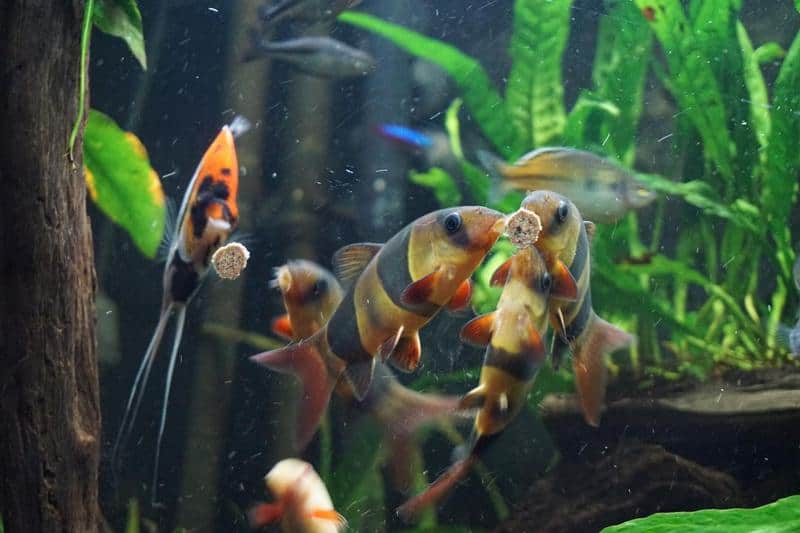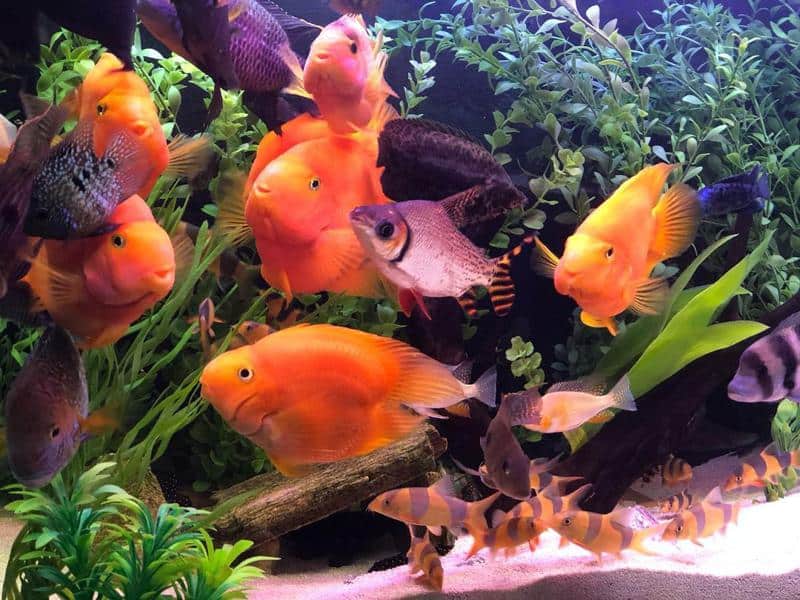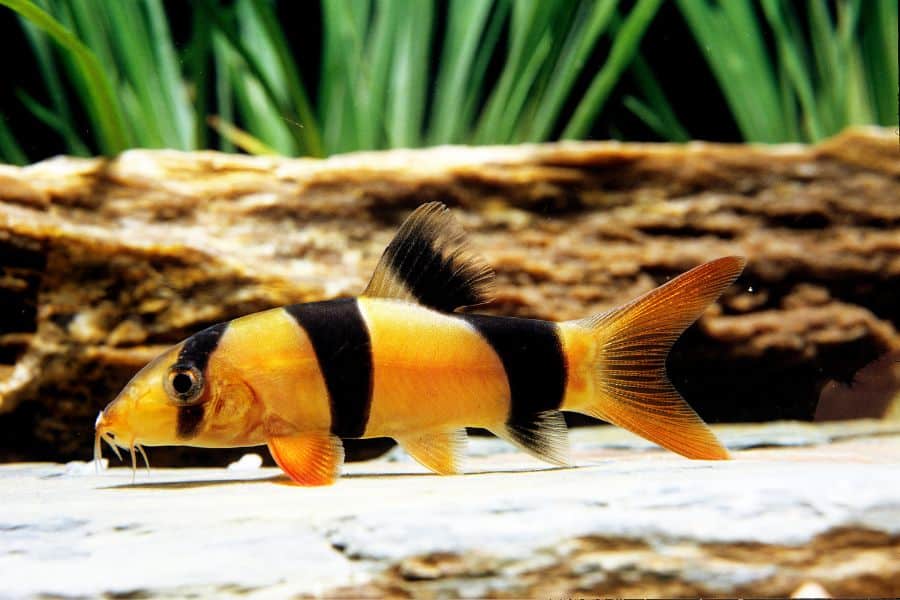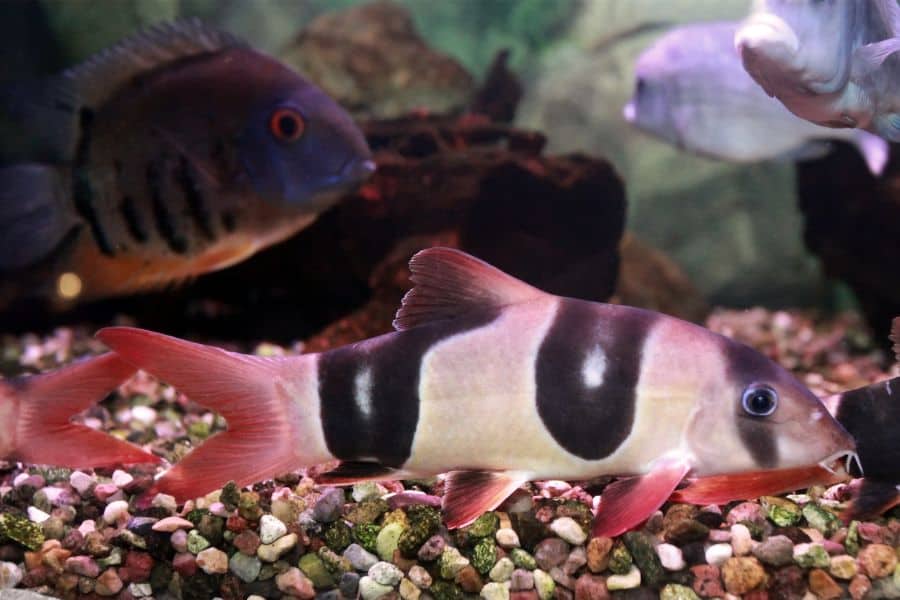Aside from its exquisite beauty, the Clown loach has caught the hearts of many due to its quirky personality. In fact, Clown loaches get their name because they do weird things that amuse their spectators.
Quite the clowns, their antics include lying on top of each other and swimming upside down. One thing you’ll often hear from hobbyists is that they will give you multiple scares before you figure out that they’re only joking!
If you’ve also been captivated by the Clown loach and looking into getting some soon, then this guide is for you.
Natural Habitat and Origin
In 1852, Dr. Pieter Bleeker described the Cobitis macracanthus. Dr. Maurice Kottelat changed the scientific name to Chromobotia macracanthus later in 2004. Currently, the Clown loach is the only fish belonging to its genus.
The species hails from the rivers and tributaries of Borneo and Sumatra. Most of the year, the fish dwell in the flowing rivers until the onset of the monsoon season. The loaches would then retreat to the flooded areas of the rainforest to spawn.
In its native waters, the Clown loach serves as a valuable food source for nearby residents. But the beautiful and intriguing fish is a well-sought pet across the world.
Clown loaches remain abundant across their home range, as they spawn in large numbers. The International Union for Conservation of Nature and Natural Resources has classified the species as “least concerned.”
The Indonesian government also implemented restrictions to prevent rapid population decline. The government prohibits the capture of Clown loach over 6 inches (5 centimeters).
Size and Growth Rate
Juvenile specimens in pet stores are often 2 to 3 inches in length. Any smaller than this is still too young.
A common misconception about the Clown loach is that it is a small species, but this is definitely not the case. The average size of an adult Clown loach is anywhere between 8 to 12 inches long (20 to 30 centimeters).
However, Clowns have a slow growth rate, with an average of 1 to 2 inches for the first six years. Then the fish grow about a half to an inch per year in the succeeding years until they reach their maximum size.
It would take approximately 9 years to see these fish turn into gigantic beauties. Clowns are great pets for the long haul, and you’ll certainly cultivate a deep bond with them.
Appearance
Catching the eye of anyone, the Clown loach makes a fantastic conversation piece!
Like the marine Clownfish, the Clown loach features an eye-popping orange base color. But instead of white, they have wide black stripes with white borders.
These black stripes can extend to their fins, one of which looks like a mask. The fins and tail of the Clown loach are vivid red.
The Clown loach moves in and out of confining spaces with ease due to its long, narrow body. This benthic dweller features a flattened belly which contrasts its arched dorsal line.
Whisker-like barbels surround its pointed mouth. Up close you will find spines underneath each eye that serve as a defense mechanism.
Some people confuse the species with the Royal Clown loach, while others call it the Tiger loach. But the Royal Clown loach and Tiger loach are two different species of fish.
Temperament
Clown loaches are peaceful quirky fish, but their bizarre behaviors frighten their owners. Here are some behaviors observed in a Clown loach, of which are pretty normal in a healthy happy fish.
Clown Loach Sleeps in Odd Positions
Sometimes, these fish scare their caretakers by playing injured or dead. Don’t worry; remaining pretty motionless is how the Clown loach sleeps or rests. But unlike other loach species that are nocturnal, Clown loaches bring your tank to life any time of the day.
Are Clown Loaches Social? Yes!
Clowns have an upbeat demeanor, and they get along well with almost any social fish. Also, there have been notable instances where the fish recognize their owners.
These loaches are quite entertaining when they swim together. They rummage through the substrate in search of food and poke holes in plants. These fish also like to move decorations around.
But because the Clown loach is a schooling species, they need large numbers to thrive. They do best when kept in a group of at least 6.
When the fish feel happy and safe, their true personalities shine as they get more active. Keeping them in low numbers would cause them to develop a reserved personality.
Are Clown Loaches Aggressive? No!
These fish might inspect others out of curiosity, but they are not aggressive. But after some time, the largest loaches may spar against each other to decide on the Alpha.
You’ll see astonishing interactions when the duel occurs. Interestingly enough, the Alpha is often a female.
Clown Loach Makes Loud Cracking Noises
Clowns make loud cracking noises, as though your tank is about to break. You might worry your fish is getting aggressive, but it is a normal Clown loach behavior.
Hearing loud cracking noises is one common occurrence among loach owners. The noise occurs when the fish grind their pharyngeal teeth while feeding.
Lifespan
Locals report that Clown loaches can live for up to 25 years in pristine natural conditions. In captivity, the species can live a little over 10 years.
As with any fish, a variety of factors can affect its life expectancy. While the hardy breed can live up to a decade, neglect can cut short the long Clown loach lifespan.
Tank Setup
Replicate the Clown Loach’s natural habitat by following the suggestions below. The goal is to help your fish adapt to their new environment quickly. Once they’ve settled in, they’ll feel adventurous and come out more often.
Tank Size
Keep in mind that Clowns can grow up to a foot, and you need to keep at least half a dozen of these fish. But because the species has a slow growth rate, you can start with 55 gallons.
You’ll have to transfer them to a 125-gallon tank or larger when they’re adults. Still, you’ll have plenty of time before you need to make an upgrade.
Substrate
Mix sand and gravel to mimic the Clown loach’s natural environment. Gravel is especially ideal for a planted tank, as they provide a strong anchor point for the roots.
For a 55-gallon tank, layer 2 inches of gravel substrate. Anything larger requires a depth of at least 3 inches.
Be careful when choosing gravel, as it could injure the sensitive barbels of your fish. Avoid pea gravel and other kinds that have jagged edges.
Damaged barbels leave your fish vulnerable to bacterial infection.
Plants and Decorations
While Clowns like to roam around during the day, they have a preference for subdued lighting. You can dim the lights using floating plants, such as:
- Frogbit
- Lilies
- Lotuses
- Water Spangles
Clown loaches like to hide among plants, too. But because these fish tend to nibble on plants, choose hardy ones with tough leaves, such as:
- Amazon Sword (Echinodorus grisebachii)
- Anubias Barteri
- African Water Fern (Bolbitis heudelotii)
- Flame Moss (Taxiphyllum flame)
- Swampweeds (Hygrophila)
- Java Fern (Leptochilus pteropus)
- Java Moss (Taxiphyllum barbieri)
When it comes to live plants with root systems, remember to plant them firmly into the gravel. Otherwise, your Clowns might uproot them whenever they rummage the bottom for food.
Moreover, do not obstruct their path by overcrowding the middle with plants. Add rock formations and other hiding spots at the left and right sides of the aquarium.
Water Parameters
Clown loaches thrive in clean, well-oxygenated water. So, invest in an efficient filter, water heater, water pump, and water test kits to maintain the recommended parameters.
Proper equipment plays a crucial role in the preservation of your aquarium’s ecosystem.
Water Temperature
You can keep the temperature running between 75 to 81 degrees Fahrenheit. But as much as possible, you’ll want to keep the temperature in the upper range.
Clowns do so much better in warm water, as it keeps their metabolism up. They fight off Ich better in warm water, too.
If their tank mates can tolerate it, run the heater anywhere between 85 to 86 degrees Fahrenheit.
Water Flow Rate
These peaceful bottom-dwelling fish have a preference for fast-flowing, oxygen-rich water.
For a 55-gallon tank, you can achieve good circulation using a canister or HOB filter. But because you’re using a filter for primary circulation, you’ll need to be more thorough about maintenance.
As your fish grow bigger, you’ll need to add one or two water pumps to create even circulation across a larger tank. Better yet, combine it with a powerhead to replicate a river habitat.
Be mindful of other fish when placing the powerhead. Don’t install a powerhead straight at a popular hang-out spot in your aquarium.
Water Hardness and pH Level
One of the best things about the Clown loach is that they’re hardy. These fish are not particularly demanding in terms of pH and hardness.
You can keep these loaches in a community tank with a pH level of around 6 to 7.5 and water hardness between 5 to 15 dGH. As long as there are no frequent fluctuations, these resilient fish should be fine.
If you need to raise the pH, add a teaspoon of baking for every five gallons of water. If the water has become too alkaline, put a clump of peat moss into a mesh bag and dip it inside the tank.
Diet and Feeding

The Clown loach is omnivorous.
In the wild, the fish feast on a wide variety of food, including snails and crustaceans. They also snack on algae and decaying plant matter at the bottom of the river.
While these loaches are benthic feeders, they may swim higher up if food is scarce. They relish small invertebrates and mosquito larvae from the water surface.
High-quality premade shrimp wafers and color-enhancing pellets are a great diet staple. These foods sink, which is excellent since the fish prefer to feed closer to the bottom of the tank.
Clown loaches will accept dry food, but you’ll want to replicate what these fish would have eaten in the wild. You need to provide the same level of variety in captivity to ensure optimal health.
Without question, your fish will eat blackworms and bloodworms with gusto. They are also more than happy to solve a snail problem if you have one.
You may also include freeze-dried daphnia and krill. Frozen food offers much greater convenience and value for money. The downside is that they have lower nutritional content.
Breeding
Breeding Clown loaches in captivity often end in frustration. Fish enthusiasts can only rely on foreign imports to meet the growing demand.
Some commercial breeders claim they have succeeded. However, there are no records of them documenting the entire process.
In the wild, monsoon floodings, which occur twice a year, force Clown loaches to occupy small murky rivers and streams. There, the females lay eggs that carried with the current.
Best Clown Loach Tank Mates

The Clown loach is one of the best community fish for a social aquarium. Given that they are bottom dwellers, they will not compete for the middle and top levels of the tank.
In the wild, you can find this species co-existing with:
- Asian arowana (Scleropages Formosus)
- Barred Rainbowfish (Chilatherina fasciata)
- Comb-Spined catfish (Cinetodus carinatus)
- Hard-lipped Barb (Osteochilus hasseltii)
- Spotted Coolie Loach (Angio shelfordii)
- Tiger Barbs (Puntius tetrazona)
In that light, the above-mentioned fishes will do well with the Clown Loach when kept in captivity.
You may also include other peaceful schooling species, such as:
- Black Widow Tetras (Gymnocorymbus ternetzi)
- Cherry Barbs (Puntius titteya)
- Neon Tetras (Paracheirodon innesi)
- Zebra Danios
Clowns will work perfectly with many options, as long as they share the same water parameters.
More impressively, they can handle their own against a certain species of cichlids. Clowns are fast; they can outpace their pursuers easily. And together, the fish stand up against bullying.
However, keep in mind that Clown loaches grow slowly. So, it isn’t wise to mix them with large fully grown species until they are at least six inches.
Common Diseases
Clown loaches are hardy, adaptable fish, but they have one problem: Ich.
Stress compromises your Clown loach’s immunity, making the fish susceptible to infection. Your fish could get stressed due to incompatible tank mates, poor water quality, and so forth.
Since Clown loaches are scaleless, they don’t respond well to typical copper-based treatments or formulas containing formalin and malachite green.
While many hobbyists recommend keeping the water hot, this is not always feasible, especially in a community aquarium. Relying on heat alone does not kill all strains of Ich.
So if you’re planning to get Clown loaches, make sure the fish have been in your local fish store for at least a week. If the fish has Ich, the symptoms will manifest within that timeframe.
Even if the loaches aren’t showing signs of Ich, you still need to quarantine them before you introduce them into your main tank. If your loaches have gone down Ich, you can use quinine to cure this malady.
Read More:
Wrapping Up
The Clown loach is straightforward to care for since it is an adaptable species. As aquarium technology continues to improve, Clown loaches can now live longer and grow bigger than before.
Regardless, you don’t want to skimp on care as they are quite vulnerable to Ich. And while these fish will happily devour scraps, they are better off with a high-quality diet of live or frozen foods.
These loaches are tolerant of most fish, which makes them suitable for a community setup. Adding to that, they don’t prey on small fish, unless they are tiny enough to fit their mouths.
However, don’t forget that these fish can grow enormous, plus you need to keep at least six of them. As far as breeding goes, you might want to hold off for something feasible.


